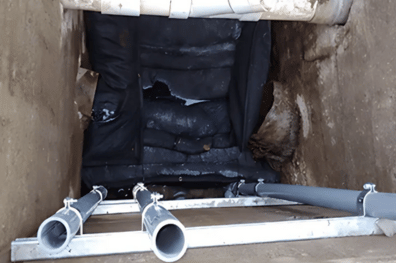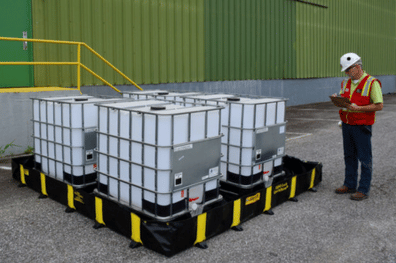ORIN conducted a pilot test to treat PFAS impacted surface water flowing through collection vaults using BAM filled booms (8” diameter) and pillows (6” thick). The booms were customized to fit the dimensions of the vault for maximum BAM / surface water contact. BAM booms were placed into the vault and passive flow surface water was in contact with the Booms and Pillow for 27 days before initial inlet / discharge samples were collected for laboratory analysis.
The Challenge
The site required treatment of PFAS-impacted surface water with:
- Initial PFOS levels: 1,120 ng/L
- Initial PFOA levels: 143 ng/L
- Total combined PFAS: 4,530 ng/L
- Need for passive treatment solution
- Collection vault flow management
The Solution: Custom BAM Deployment
The team implemented an innovative passive treatment approach:
- Treatment Technology:
- BAM-filled booms (8″ diameter)
- BAM pillows (6″ thick)
- Custom-sized for vault dimensions
- Maximized water contact surface area
- Implementation Strategy:
- Strategic boom placement
- Passive flow utilization
- 27-day treatment period
- Minimal intervention required
Impressive Results
After 27 days of passive treatment:
PFOS Reduction:
- Initial: 1,120 ng/L
- Final: 290 ng/L
- Reduction: 74%
PFOA Reduction:
- Initial: 143 ng/L
- Final: 38.5 ng/L
- Reduction: 73%
Total PFAS Reduction:
- Initial: 4,530 ng/L
- Final: 1,231 ng/L
- Overall Reduction: 73%
Key Success Factors
Several elements contributed to the project’s effectiveness:
- Custom-designed containment systems
- Maximized contact surface area
- Strategic placement in flow path
- Optimal treatment duration
- Passive flow utilization
Innovation Highlights
The project demonstrated several advantages:
- Low maintenance requirements
- No energy inputs needed
- Simple implementation
- Consistent treatment results
- Adaptable design potential
Practical Applications
This approach provides solutions for:
- Surface water treatment
- Collection system management
- Passive PFAS reduction
- Flow-through treatment systems
- Limited-access locations
This pilot study demonstrates how simple, well-designed solutions can achieve significant PFAS reduction with minimal operational requirements.



